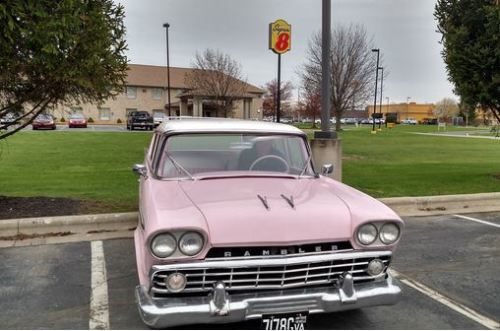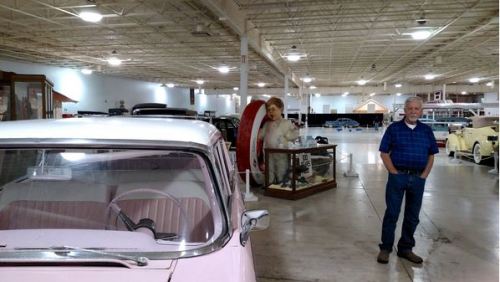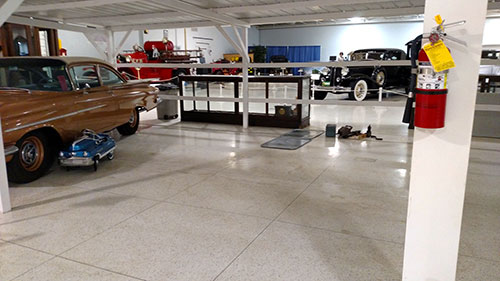Rosie At Rest

The rain started spattering against the side of the Kokomo Holiday Inn Express around three AM. My brother was snoring in the bed next to me, and suddenly awake, I began to think beyond the end of the mission, when the Pepto-Bismo-colored flanks of the classic Rambler Station Wagon would take up her position in the Auto Museum. Just a few minor details to accomplish, then Mission Complete and on to the next thing, which was to deposit half the team at the Indianapolis International Airport and flog the modern car back East.
What could go wrong now? With only a couple minor hiccoughs on the way, Rosie’s straight-six engine had cranked her way up from Pensacola for voyage repairs in Culpeper, and pressed her chromed snout up the Shenandoah Valley, up over the Eastern Continental Divide at Town Hill, through West Virginia and Pennsylvania’s plateau, and down over the deep vale carved by the Ohio River.
The weather had been fickle, but ultimately kind. The sudden blizzard on the heights of West Virginia was an unpleasant surprise- and the specter of a salt bath from the roads, or some blinding coating on Rosie’s un-wipered windshield was briefly daunting. The snow-cells passed without major event, and the whitened fields rolled by.
Then the weather guessers said that the Great Rain was coming, but we were in Kokomo hours before, and safe in our rented beds before the drops pelted the side of the building.
Rosie had answered all bells for nearly 1,600 miles of the great American highway, just as she had when she rolled out of the plant at Kenosha, Wisconsin in her pastel glory in 1959. Ike was President, and life (and society) was framed with a certain modicum of sense and decency.
Before the last evolution of the adventure, Spike and I tucked into a decent breakfast- one of the reasons we decided to stay in this chain for the duration of the trip- and the coffee was piping hot and warming against the unseasonable chill. Then we packed up all the charging-cords, sundry devices, support equipment, tools and bags and hauled them down to the elevator, past Stacey at the Guest Registration Desk, and out to the Panzer in a break between the sheets of rain.
All we had to do was drive the five miles from the hotel to the Museum and complete Rosie’s induction into a sort of interim automotive immortality.
I arranged bags in the back and got in the Mercedes and started it up. Spike got in Rosie and signaled he was about to turn the key. He did so, the engine almost caught, and then it died.
And it was a hard death. Spike popped the hood and we looked at the spacious engine compartment that glistened with moisture.
“Looks like the rain came in sideways,” my brother said.
“Indeed. Poor girl. Let me pull up and the jumper cables on.”
We did that to no avail, not that you can even find the battery on the product of the German engineering. No kidding. It is the complete and diametric opposite to the straightforward approach of the Rambler. Here is the battery, there is the oil and radiator covers. All the belts and hoses are available to be touched and tweaked.
On the Panzer, the engine itself is protected by a solid metal shield, apparently designed to defeat shade-tree interference with the precision design. I am not even sure why they have hoods- there is nothing that can be adjusted or even touched. To access the battery, a panel has to be removed, or at least it seemed so. At length, and with the aid of the Germanic owner’s manual, we thought we had a charge going, but no dice.
Even a couple of solid Hoosier workmen and their truck could not stir anything in Rosie’s pink bosom. We thanked the Hoosiers and tried to come up with a plan.
“We could buy some webbing and tow it with the Mercedes,” said Spike hopefully.
“No,” I said. “That is what tow trucks are for.”
“Maybe we should go to the Museum and see if they have a truck.”
“Sub-optimal, but off we go.”
We climbed into the SUV and drove directly to the wrong address that I had programmed into the GPS. Then we stopped to re-group outside a drive-through shack called “Hippy Shakes,” not far from the Dog and Suds. Spike checked the real address- on North Reed- and said: “Says the Museum is closed today.”
“What?” I responded cleverly. “Crap. It didn’t say that last week.”
We drove another mile or two down the road and found the Convention Center and parked out front. There were a few cars in the vast lot. “There is a light on in there,” I said hopefully. We parked in a place next to the door, and were relieved to find the doors open to a lobby that fronted on a large hall filled with exhibition booths unadorned and forlorn.
A pretty lady- her name was Tricia- sat in an office off the lobby, and we entered, introduced ourselves, and explained we were here to deliver a classic car. “I’m sorry,” she said. “I am with the convention center, I have not seen anyone from the Museum this morning, I don’t know if anyone is coming in. Did you have an appointment?”
“I sent an email last week to confirm our arrival,” I said. Spike looked at me with an arched eyebrow. “But no, I didn’t get anything back.” Tricia said she would make a couple calls, and we went out to sit on the couch in the darkened lobby.
“We could just leave the keys with Tricia and tell them where the car is, and get on down the road so you can make your flight.”
“We have two hours,” Spike said. “No reason to panic yet.” I thought dark thoughts about schedules and appointments in another state.
And really, there wasn’t any reason to panic. I live in Washington, so I am accustomed to things not working, problems being insoluble, frustrations immense, and hostilities deeply entrenched. I had forgotten that this was the real America, where people get things done.
It turned out that Jeff was upstairs in the Museum space doing paperwork. He came down and we introduced ourselves and explained our challenges. He seemed surprised that we had driven almost all the way from Virginia to Indiana. Apparently not all the vehicles arrive that way. Jeff called Jim, the curator, and J.D., the duty driver for the Martin Wrecker Service, “Serving Kokomo since 1938.”
“Meet J.D. back at the hotel, he will haul the car back here, Jim will have the paperwork, and we will get you on your way.”

And that is exactly the way it worked. Within a half hour, Rosie was on the truck and deposited at the back door to the Museum. We paid for the tow, and pushed her into the high-bay at the back of the exhibit area. She looked good, for all the miles we had just put on her.
“We don’t have any station wagons in the collection,” said Jeff. “No one seemed to think to save them.”
“And I will bet it is the only pastel car, too,” said Spike. Then he explained about the items that our Dad had contributed to the design. “The Dip is the most significant,” he said, gesturing to the distinctive downward slope of the luggage rack. “It was intended to let them use the same roof tooling for both the sedan and the wagon models. He did the door handles with a sort of Art Deco flair, and the distinctive Rambler “R” insignia on the steering wheel and the hubcaps.” He paused for a moment. “Rosie is sort of a rolling tribute.”
Jim produced some paperwork that I filled out with the exhibition period marked “indefinite.” He indicated they completely understood if we wanted to pull her out to show at the big meet in August, and before he left, J.D. said he would even haul her to the show for the flat rate, plus three dollars a mile, just in case.
Hoosiers are really nice people. On the way out, Jim even showed us the bay where Rosie is going to live, near a Chevy sedan with the curved fins. Rosie was home.

Copyright 2016 Vic Socotra
www.vicsocotra.com

Note: Here is Rosie’s Roost. Everything else was an anticlimax. The weather cooperated only enough to get Rosie bedded down. Then the rains came, and spent the rest of the day soaking all in its path. We successfully got my brother delivered to the Indianapolis Airport, 45 miles to the south, and then my sorry butt back on I-70E through Dayton to Columbus before I fell apart. In a gray haze of spray, I gave up and stayed at a Holiday Inn Express north of there. It is an hour and something up I-71 to Seville and Jinny’s funeral this afternoon. The skies are now fresh-washed and clear again, being fully cooperative when things really count. Then the rest of the drive back to the Capital- or at least in the direction of it. It is only six hours from there, and really, how hard could that be? What could possibly go wrong?
